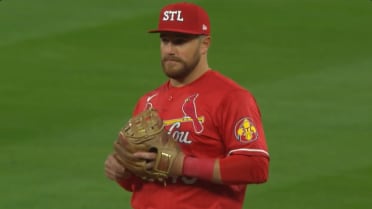Video rooms were closed, real-time game footage was barred, punishments were threatened and postseason games were moved to neutral sites. In this 2020 season, the technological misdeeds that led to so much breath and bandwidth about the '17 World Series champion Astros would not appear to be possible.
“Legal” sign-stealing, on the other hand, is still very much in play.
“If you’re stealing signs at second base, that’s part of the game,” Rays manager Kevin Cash said. “So shame on us if we’re going to fall into the same sign sequences.”
During their postseason run, Cash’s Rays have faced two American League opponents -- the Yankees and Astros -- known in the industry to be especially adept at decoding opponent signs the old-fashioned way. So the Rays have a system in place to switch up their signs on the fly.
It’s a subtle system, but one you might have noticed many Major League pitchers using in recent seasons, often with a midgame tip of the cap.
In the age of sign-stealing paranoia, pitchers have taken to consulting laminated cards tucked in their caps -- or, alternatively, back pockets -- which list various sign systems that can keep opponents guessing. Catchers typically have the same information cards attached to their wristbands.
“I’m actually surprised that it took that long for all of baseball to get on board with that,” Cash said. “But it’s pretty simple. And the good thing with those cards is you’re not taking the pitcher out of his rhythm.”
In-game “cheat sheets” are popular among outfielders for in-game defensive positioning shifts guided by analytical data. Pitchers obviously don’t need them for that specific purpose. But their cards allow pitchers and catchers to shift sign sequences without making unnecessary mound visits -- an important factor, given the mound visit limitations that were first put in place in 2018 (teams can only make five visits per nine innings).
Last year’s World Series champion Nationals are an example of how teams adjust their sign patterns within a game.
Per the reporting of the Washington Post after the Astros’ scandal broke, the Nats had five sets of signs for each pitcher during the Fall Classic. If Houston appeared to be catching on to one set, the pitcher or catcher could signal to switch to the other. Washington’s catchers, Yan Gomes and Kurt Suzuki, also varied the way the signs were given. In a particular inning, they might “chase the two,” meaning the real sign was the one that followed the catcher putting two fingers down. Or they might do “strikes plus one,” meaning that, if there was one strike, the correct sign would be the second one put down.
“We just had our guard up,” Nationals reliever Sean Doolittle told the Post.
Teams can’t afford to fall into detectable patterns. Even with video replay rooms shut down this year as part of health and safety protocols and the iPads allowed in the dugout limited to pre-loaded video (in other words, old footage and not at-bats from the current game), some teams are still, understandably, guarding against clubs that are skilled at picking up pitch tipping or sign sequences legally.
And it doesn’t have to be done via card. Astros pitcher Zack Greinke got a lot of attention during the AL Division Series for flashing two fingers to his catcher with Ramón Laureano at the plate. The national broadcast speculated that Greinke was bravely telling catcher Martín Maldonado which pitch was coming.
In reality, Greinke was just confirming with Maldonado which set of signals were being used with a runner on second base.
“I’ll switch up my signs consistently,” Rays pitcher Tyler Glasnow said. “Me and Z [catcher Mike Zunino] discuss what our signs are for that game and know each other’s body signals, so we don’t have to really look in the hat as much. But [the cards are] helpful for a lot of guys.”
Crib notes are not new to baseball.
Way back in 1988, prior to Game 2 of the World Series, meticulous Dodgers pitcher Orel Hershiser, having been too excited about Kirk Gibson’s epic homer a night earlier to remember to take the game tape home with him, had to do some day-of-game cramming in the clubhouse. Worried he wouldn’t be able to memorize everything so quickly, he jotted his notes down on an index card, tucked it in his pocket, then alerted the umpires prior to first pitch.
“I remember saying to them, ‘When I reach into my pocket, this is what I’m getting,’” Hershiser told the Los Angeles Times in 2018. “And I showed them the card. It wasn’t an emery board [used to scuff the ball] or anything else that people have been caught with.”
But index cards of this ilk really came in vogue when technology-based sign-stealing became a not-so-secret threat. Because they were thoroughly investigated, the 2017 Astros and '18 Red Sox might be the most infamous examples of teams using technology to cheat, but they were hardly the only ones. Teams had to find a way to combat it.
“What it requires,” D-backs general manager Mike Hazen told reporters earlier this year, “is a more complex and different array of sign systems. Not just falling into the same pattern series of a couple of different signs that good position players can pick up pretty quickly.”
It's all in the cards.
Late in the 2018 season, Phillies reliever Austin Davis twice consulted an index card he had kept in his back pocket during an outing against the Cubs. Umpire Joe West confiscated the card, citing Rule 6.02(c)(7), which states that the pitcher shall not “have on his person, or in his possession, any foreign substance.”
MLB clarified soon thereafter that the cards are OK, provided that consultation of the cards does not delay the game.
Pirates pitcher James Marvel may have been guilty of that during a start late in the 2019 season, when about 2 1/2 minutes passed between pitches. Clearly having trouble communicating, Marvel and catcher Elías Díaz cycled through various signs, with both men consulting their laminated cards. Eventually, they had to give up and have a mound visit.
Yankees pitcher CC Sabathia had a different sort of issue with his card during a 2019 game. As documented by The New York Times, Sabathia took off his cap, looked inside and was perplexed by the absence of his info card. He examined the mound for a moment before realizing where it was:
Stuck to his bald head.
So the cards aren’t necessarily foolproof. By and large, though, pitchers consult them so subtly that the average fan probably doesn’t even notice. Watch the World Series closely, and you’ll probably see them. The key to capping sign-stealing is in the cap itself.
Anthony Castrovince has been a reporter for MLB.com since 2004.




